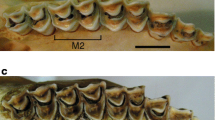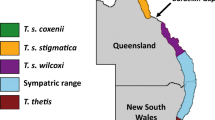Abstract
Elephants do not replace deciduous teeth once with permanent teeth as most mammals, but replace a single cheek tooth per jaw-side five times in their lives in a process called molar progression. While this gradual process has been well-documented for the purpose of age determination, a less-considered possible side effect of this progression is that functional chewing surface fluctuates, being larger when two cheek teeth are both partially in use and smaller when only one cheek tooth is used fully. We found that body mass of both breeding and non-breeding female zoo elephants (Elephas maximus, Loxodonta africana) shows a cyclic undulation with peaks separated by many years, which is therefore unrelated to reproduction or annual seasonality. We propose variation in functional chewing surface, resulting chew¬ing efficiency, and resulting increased food intake and/or digestive efficiency as the underlying cause. As elephants reproduce all year-round and thus are not synchronized in their molar progression pattern, climate-related fluctuations in resource availability are likely to mask this pattern in free-ranginganimals. In contrast, it emerges under the comparatively constant zoo conditions, and illustrates the relevance of the dental apparatus for herbivorous mammals. The combination of variable chewing efficiency and resource availability in free-ranging elephants may render these species particularly prone to reported inter-individual fitness differences.
Similar content being viewed by others
References
Anders, U., von Koenigswald, W., 2013. Increasing and decreasing functional area of the dentition (FAD) of Mammuthus primigenius. Palãontol. Zschr. 87, 515–527.
Bjorndal, K.A., Bolten, A.B., Moore, J.E., 1990. Digestive fermentation in herbivores: effect of food particle size. Physiol. Zool. 63, 710–721.
Brown, J.L., 2014. Comparative reproductive biology of elephants. In: Holt, W.V. (Ed.), Reproductive Sciences in Animal Conservation. Springer Science+Business Media, New York, pp. 135–169.
Chusyd, D.E., Brown, J.L., Hambly, C., Johnson, M.S., Morfeld, K.A., Patki, A., Speakman, J.R., Allison, D.B., Nagy, T.R., 2018. Adiposity and reproductive cycling status in zoo African elephants. Obesit. 26, 103–110.
Clauss, M., Loehlein, W., Kienzle, E., Wiesner, H., 2003. Studies on feed digestibilities in captive Asian elephants (Elephas maximus). J. Anim. Physiol. Anim. Nutr. 87, 160–173.
Clauss, M., Steinmetz, H., Eulenberger, U., Ossent, P., Zingg, R., Hummel, J., Hatt, J.M., 2007a. Observations on the length of the intestinal tract of African Loxodonta africana (Blumenbach 1797) and Asian elephants Elephas maximus (Linné 1735). Eur. J. Wildl. Res. 53, 68–72.
Clauss, M., Streich, W.J., Schwärm, A., Ortmann, S., Hummel, J., 2007b. The relationship of food intake and ingesta passage predicts feeding ecology in two different megaherbivore groups. Oiko. 116, 209–216.
Clauss, M., Steuer, P., Erlinghagen-Lückerath, K., Kaandorp, J., Fritz, J., Südekum, K.H., Hummel, J., 2015. Faecal particle size: digestive physiology meets herbivore diversity. Comp. Biochem. Physiol.. 179, 182–191.
Codron, J., Codron, D., Sponheimer, M., Kirkman, K., Duffy, K.J., Raubenheimer, E.J., Mé lice, J.L., Grant, R., Clauss, M., Lee-Thorp, J.A., 2012. Stable isotope series from elephant ivory reveal lifetime histories of a true dietary generalist. Proc. R.SOC.. 279, 2433–2441.
Cornwall, I.W., 1956. Bones forthe Archaeologist. Phoenix House Ltd, London.
Fischer, M., Houston, E.W., OSullivan, T., Read, B., Jackson, P., 1993. Selected weights for ungulates and the Asian elephant Elephas maximus at St Louis Zoo. Int. Zoo Yb. 32, 169–173.
Foley, C.A.H., Papageorge, S., Wasser, S.K., 2001. Noninvasive stress and reproductive measures of social and ecological pressures in free ranging African elephants. Conserv. Biol. 15, 1134–1142.
Fowler, M.E., Mikota, S.K., 2006. Biology, Medicine, and Surgery of Elephants. Blackwell Publishing, Iowa, USA.
Frade, F., 1955. Ordre des proboscidiens. Traité de Zoologi. 17, 715–783.
Freeman, E.W., Guagnano, G., Olson, D., Keele, M., Brown, J.L., 2009. Social factors influence ovarian acyclicity in captive African elephants (Loxodonta africana). Zoo Biol. 28, 1–15.
Fritz, J., Hummel, J., Kienzle, E., Arnold, C., Nunn, C., Clauss, M., 2009. Comparative chewing efficiency in mammalian herbivores. Oiko. 118, 1623–1632.
Fritz, J., Streich, W.J., Schwärm, A., Clauss, M., 2012. Condensing results of wet sieving analyses into a single data: a comparison of methods for particle size description. J. Anim. Physiol. Anim. Nutr. 96, 783–797.
Grandl, F., Schwärm, A., Ortmann, S., Furger, M., Kreuzer, M., Clauss, M., 2018. Kinetics of solutes and particles of different size in the digestive tract of cattle of 0.5 to 10 years of age, and relationships with methane production. J. Anim. Physiol. Anim. Nutr. 102, 639–651.
Hanks, J., 1972. Growth of the African elephant (Loxodonta africana). E. Afr. Wildl. J. 10, 251–272.
Hatt, J.M., Clauss, M., 2006. Feeding Asian and African elephants (Elephas maximus and Loxodonta africana) in captivity. Int. Zoo Yb. 40, 88–95.
Ikebe, K., Matsuda, K.I., Kagawa, R., Enoki, K., Yoshida, M., Maeda, Y., Nokubi, T., 2011. Association of masticatory performance with age, gender, number of teeth, occlusal force and salivary flow in Japanese older adults: is ageing a risk factor for masticatory dysfunction? Arch. Oral Biol. 56, 991–996.
Jarofke, D., 2007. Jarofkes Elefantenkompendium. Schilling Verlag, Münster.
Johnson, O.W., Buss, I.O., 1965. Molariform teeth of male African elephants in relation to age, body dimensions, and growth. J. Mammal. 46, 373–384.
Kalita, S.N., Sarma, M., 2003. Anatomy of elephant: some important features. In: Das, D. (Ed.), Health Care, Breeding and Management of Asian Elephants. College of Veterinary Science, Assam Agricultural University, Assam, India, Assam, India.
Keet, D.F., 1991. An approach to the autopsy of the African elephant. In: Van Heerden, J., Penzhorn, B.L. (Eds.), Symposium on The African Elephant as a Game Ranch Animal, 95–104.
King, S.J., Arrigo-Nelson, S.J., Pochron, S.T., Semprebon, G.M., Godfrey, L.R., Wright, P.C. Jernvall, J., 2005. Dental senescence in a long-lived primate links infant survival to rainfall. PNA. 102, 16579–16583.
Kojola, L., Helle, T., Huhta, E., Niva, A., 1998. Foraging conditions, tooth wear and herbivore body reserves: a study of female reindeer. Oecologi. 117, 26–30.
Krumrey, W.A., Buss, I.O., 1968. Age estimation, growth, and relationships between body dimensions of the female African elephant. J. Mammal. 49, 22–31.
Lang, E.M., 1980. Observations on growth and molar change in the African elephant. Afr. J. Ecol. 18, 217–234.
Lang, E.M., 1994. Wachstum und Zahnwechsel beim Afrikanischen Elefanten (Loxodonta africana) im Tiergarten. Zool. Garten N. F. 64, 57–77.
Laws, R.M., 1966. Age criteria forthe African elephant, Loxodonta a. africana. E. Afr. Wildl. J. 4, 1–37.
Lee, P.C., Sayialel, S., Lindsay, W.K., Moss, C.J., 2012. African elephant age determination from teeth: validation from known individuals. Afr. J. Ecol. 50, 9–20.
Lee, P.C., Bussière, L.F., Webber, C.E., Poole, J.H., Moss, C.J., 2013. Enduring consequences of early experiences: 40 year effects on survival and success among African elephants (Loxodonta africana). Biol. Lett. 9, 20130011.
Logan, M., 2003. Effect of tooth wear on the rumination-like behavior, or merycism, of free-ranging koalas (Phascolarctos cinerais).]. Mammal. 84, 897–902.
Maglio, V., 1973. Origin and evolution of the elephantidae. Trans. Am. Phil. Soc. 63, 1–149.
Momin Khan, M.K., 1977. Aging of elephants: Estimation by foot size in combination with tooth wear and body dimensions. Malayan Nature Journa. 30, 15–23.
Pérez-Barbería, F.J., Gordon, I.J., 1998. The influence of molar occlusal surface area on the voluntary intake, digestion, chewing behaviour and diet selection of red deer. J.Zool. 245, 307–316.
Pokharel, S.S., Seshagiri, P.B., Sukumar, R., 2017. Assessment of season-dependent body condition scores in relation to faecal glucocorticoid metabolites in free-ranging Asian elephants. Conserv. Physiol. 5, cox039.
R Core Team, 2015. R: A Language and Environment for Statistical Computing. R Foundation for Statistical Computing, Vienna.
Ranjeewa, A.D., Pastorini, J., Isler, K., Weerakoon, D.K., Kottage, H.D., Fernando, P., 2018. Decreasing reservoir water levels improve habitat quality for Asian elephants. Mamm. Biol. 88, 130–137.
Rasmussen, H.B., Wittemyer, G., Douglas-Hamilton, I., 2005. Estimating age of immobilized elephants from teeth impressions using dental silicon. Afr. J. Ecol. 43, 215–219.
Roth, V.L., Shoshani, J., 1988. Dental identification and age determination in Elephas maximus.]. Zool. 214, 567–588.
Schiffmann, C., Clauss, M., Fernando, P., Pastorini, J., Wendler, P., Ertl, N., Hoby, S., Hatt, J.M., 2018. Body condition scores in European zoo elephants (Elephas maximus and Loxodonta africana) - status quo and influencing factors. J. Zoo Aquar. Res. 6, 91–103.
Shoshani, J., 1992. Elefanten- Enzyklopädie der Tierwelt. Jahr-Verlag GmbH & Co. Hamburg, Hamburg.
Shrader, A.M., Ferreira, S.M., Van Aarde, R.J., 2006. Digital photogrammetry and laser rangeflnder techniques to measure African elephants. S. Afr. J. Wildl. Res. 36, 1–7.
Sikes, S.K., 1971. The Natural History of the African Elephant. Weidenfeld and Nicolson, London.
Skogland, T., 1988. Tooth wear by food limitation and its life history consequences in wild reindeer. Oiko. 51, 238–242.
Stansfleld, F.J., 2015. A novel objective method of estimating the age of mandibles from African elephants (Loxodonta africana africana). PLoS One 10, e0124980.
Ungar, P.S., 2010. Mammal Teeth: Origin, Evolution and Diversity. John Hopkins University Press, Baltimore.
Venkataraman, V.V., Glowacka, H., Fritz, J., Clauss, M., Seyoum, C., Nguyen, N., Fashing, P.J., 2014. Effects of dietary fracture toughness and dental wear on chewing efficiency in geladas (Theropíthecus gelada). Am. J. Phys. Anthropol. 155, 17–32.
Walker, C.C.F., Schlegel, M.L., 2013. Case study: relationship between weight gain and offspring sex in African bush elephants (Loxodonta africana africana) at the San Diego Zoo Safari Park. 10th Conference on Zoo and Wildlife Nutrition.
Author information
Authors and Affiliations
Corresponding author
Electronic supplementary material
Rights and permissions
About this article
Cite this article
Schiffmann, C., Hatt, JM., Hoby, S. et al. Elephant body mass cyclicity suggests effect of molar progression on chewing efficiency. Mamm Biol 96, 81–86 (2019). https://doi.org/10.1016/j.mambio.2018.12.004
Received:
Accepted:
Published:
Issue Date:
DOI: https://doi.org/10.1016/j.mambio.2018.12.004




